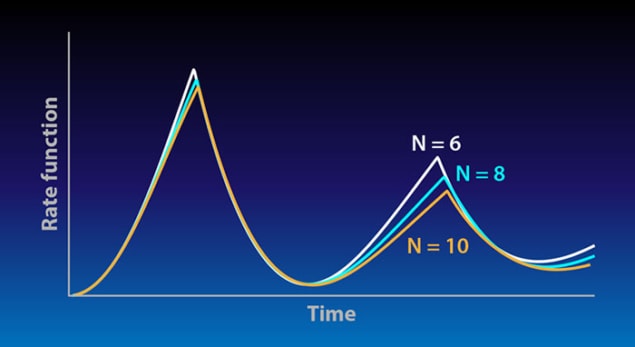
A type of quantum phase transition first predicted in 2013 has been seen by three independent teams of physicists. All three experiments involved systems of interacting ultracold atoms or ions and the observations could lead to a better understanding of the collective behaviour of quantum matter.
Phase transitions occur when matter transforms spontaneously from one state to another – from solid to liquid at the melting point of water, for example. Classical phase transitions are associated with thermal fluctuations in a system such as the random motion of water molecules. In contrast, quantum phase transitions involve fluctuations that arise from short-term changes in energy as described by Heisenberg’s uncertainty principle. As a result, quantum phase transitions tend to occur at absolute zero or very low temperatures, where quantum fluctuations dominate over thermal fluctuations.
Time passages
Phase transitions are usually studied when a system is at or near thermal equilibrium, but in 2013, Markus Heyl, Anatoli Polkovnikov and Stefan Kehrein pointed out a similarity between the mathematical operator describing the time evolution of a non-equilibrium quantum system and the partition function of a system in thermodynamic equilibrium. Furthermore, the theorists calculated that the quantum system should undergo changes of state that are reminiscent of phase transitions. The difference being that instead of being driven by a change in an external factor such as temperature, the quantum transitions occur as time progresses.
In one of the three independent experiments, Rainer Blatt of the University of Innsbruck and colleagues in Austria and Germany observed dynamical quantum phase transitions in strings of up to 10 ions trapped in an ultracold environment. The system is described by the transverse-field Ising model, whereby an interaction between neighbouring ions can be adjusted so that the ions align their spins along one direction (say x). There is also a magnetic field applied in a transverse direction (such as z), which exerts a torque on the spins.
Random directions
Beginning in an ordered state with all spins pointing in the same direction, the team then changed the interactions between the spins so that they align in random directions – driving the system away from equilibrium. The system is then allowed to evolve with time and the team measured the probability that the spins point in the same direction (a quantity called the rate function). As predicted by Heyl and colleagues, the researchers found that this occurred at two specific times – much like how conventional phase transitions occur at specific temperatures, for example. Writing in Physical Review Letters, they also explain how systems containing six, eight and 10 ions had the same behaviour.
Meanwhile Nick Fläschner of the University of Hamburg and colleagues spotted dynamical quantum phase transitions in a 2D optical lattice of ultracold atoms and describe their work on arXiv. Also on arXiv is a preprint by Christopher Monroe of the University of Maryland and colleagues describing dynamical quantum phase transitions in a string of 53 ions.



